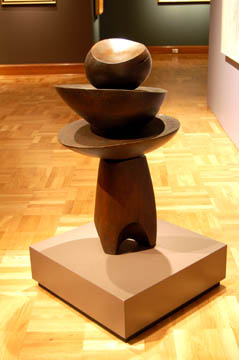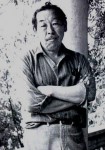
George Tsutakawa
American, 1910-1997
Obos #5, 1957
wood
34 × 19 1/2 in.
SBMA, Museum purchase, Third Pacific Coast Biennial Fund
1959.56

Undated photo of Tsutakawa
Tsutakawa's marriage of Japanese and American sensibilities is best seen in his explanation of the rationale behind the fountains for which he is best known; “Through my travels and my studies of traditional Japanese arts, I was able to reaffirm my conviction in the Oriental view of nature which sees man as one part of nature, a part that must live in harmony with the rest of nature… my fountain sculptures are an attempt to unify water—the life force of the universe that flows in an elusive cyclical course throughout eternity—with an immutable metal sculpture.” 1
RESEARCH PAPER
Obos #5 is one of a series of sculptures and fountains created by George Tsutakawa that use as their inspiration the towers of ritually stacked rocks, called obos, left by travelers to celebrate the successful crossing of a high Himalayan mountain pass.
Constructed of wood, and stained a dark brown color, the piece consists of a truncated, spheroid section at the top and two dish-shaped elements, which are stacked off-axis atop a tapered, cylindrical base. The base has three incised sections at the bottom, which form three “legs”, upon which the structure stands. All of the surfaces are sanded to a smooth finish. The individual elements are tied together by a vertical dowel, to which each piece is keyed.
Although born in Seattle, Tsutakawa spent his childhood living with his grandparents in Japan, where he was thoroughly indoctrinated in the Japanese culture and arts. He returned to Seattle at age 17 and remained a Seattle resident for the rest of his life. His sculptures attempt to reconcile the Japanese vision of art in nature with the western concept of man using technology to shape nature to his choosing. In this work, he uses modern tools (lathe, drill, grinder and sander) to produce shapes that have a definite tie to elements seen in Japanese gardens and flower arrangements.
Biographical Notes
Born in Seattle in 1910, to Japanese parents, George Tsutakawa was sent to live with his grandparents in Japan, at age 7, by his father, who was a successful proprietor of an export-import business. He remained in Japan until 1927, when, after a dispute with his father over his desire to be an artist, he returned to Seattle to live with an uncle’s family.
(His father had returned to live in Japan in the late 1920’s) During the period with his grandparents, he became immersed in Japanese arts and cultural practice. Upon returning to Seattle, he completed high school and graduated from the University of Washington in 1937, with a BFA degree in Sculpture. During his undergraduate studies, he was greatly influenced by Alexander Archipenko, who taught summer classes at the university. For several years after graduation, he worked in the family business, while pursuing his art on a part-time basis.
Enlisting in the army at the onset of WWII, he spent much of his military career painting officer’s portraits and decorating officer’s clubs with murals. Finally, he was transferred to a Military Intelligence School, where he taught Japanese language classes.
After his discharge, Tsudakawa enrolled in graduate school at the U. of Washington, where he received his M.A. degree and joined the faculty of the Arts and Architecture Departments. He taught at the university for the next 34 years. In addition, he became a well-known member of the Seattle art community, primarily as a sculptor and painter.
In 1958, the directors of the Seattle Public Library commissioned him to create his first fountain, for a downtown library, then under construction. This was the first of 74 public fountains that he created during the ensuing years. It is interesting to note that, because he could not find a foundry that could cast the intricate shapes to his satisfaction, he did not cast any of his large bronze fountains; instead, he welded them from formed sheets of silicon bronze. One of the hallmarks of a Tsudakawa fountain is that the design is such that the water always cascades downward in free fall; he disparaged fountains that “squirt” water into the air. 2
Recipient of honors from the Emperor of Japan, the State of Washington, and the University of Washington, he traveled extensively after his retirement from the University, but continued his affinity with Japanese culture by teaching classes in sumi painting. He died of a heart attack on December 18, 1997.
Footnotes
“A Personal Statement”, George Tsutakawa, Pacific Artists in Japan Exhibition Catalog, Osaka, 1982/ found in: U. of Washington UW Showcase, 1997
2 From transcript of interview with Martha Kingsburg, September, 1983/ Smithsonian Archives of American Art, Oral History Interviews.
Bibliography
1. University of Washington Office of Research, UW Showcase, 1997—accessed through http://seattle.about.com: concise biography of George Tsutakawa, unfortunately, no photos of works.
2. Smithsonian Archives of American Art, Oral History Interviews: Transcript, Interview with Martha Kingsbury, September 1983. www.aaa.si.edu/collections/oralhistories: long interview with George Tsutakawa on life and works. This collection is a treasure of ideas and history, in the words of the artists themselves.
3. Tsutakawa, George (1910-1997): Master of Fountains www.HistoryLink.org: extensive biography of Tsutakawa, with emphasis on his Japanese background and on his works; contains photos of man and his fountains.
4. www.publicartinla.com/UCLAArt/obos.html: excellent photograph of the Obos 69 fountain at the UCLA Sculpture Garden.
Prepared for the Santa Barbara Museum of Art Docent Council by Cliff Hauenstein, March, 2006
SBMA CURATORIAL LABELS
This sculpture is about dynamic balance. The bowls seem to glide and shift as you walk around the sculpture. They evoke visual and physical equilibrium as well as balance, harmony, and order. The elemental forms of Western abstraction merge with the to or butto, the Japanese pagoda, and the Buddhist practice of stone stacking, a form of prayer and ritual.
Born in Seattle to Japanese immigrants, George Tsutakawa spent his childhood in Japan, returning to the United States at age 16. After 1941, his family was moved to a concentration camp, while the artist was drafted into the U.S. Army. He admitted to spending his late adolescence and early adulthood attempting to forget his Japanese heritage and Americanize himself. He studied American and European art and cited Alexander Archipenko as a major influence; Archipenko completed an artist residency at the University of Washington, where Tsutakawa studied and later taught. However, in 1956, after nearly 30 years of working as a professional artist in a Western style, the artist revisited Japan. Realizing that something fundamental had been missing from his work, he decidedly began integrating his heritage into his practice. In his later life, he described his art as more Japanese than American.
- Going Global, 2022
